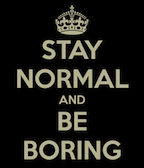 Once upon a time in the realm of corporate America, there lived a stalwart named B2B. His purposeful walk and confident grin belied his unwavering subservience to all the almighty Sales King, who demanded daily tribute in the form of leads, leads, and more leads. Then one day, quite without warning, B2B died. No one mourned. The end. (Note: If this article seems familiar, then you read it first on FastCompany.com).
Once upon a time in the realm of corporate America, there lived a stalwart named B2B. His purposeful walk and confident grin belied his unwavering subservience to all the almighty Sales King, who demanded daily tribute in the form of leads, leads, and more leads. Then one day, quite without warning, B2B died. No one mourned. The end. (Note: If this article seems familiar, then you read it first on FastCompany.com).
Or was it?
Okay, enough with the fairy tale, but here’s the truth: Long synonymous with “better to bore” communications, B2B marketing is in the process of being reborn. Leading this rebirth is a new generation of marketers like Jonathan Becher of SAP and Trip Hunter of Fusion-io, who are overturning conventional wisdom and establishing four new B2B marketing decrees that just might stand for years to come.
Culture Trumps Strategy
When he became the new CMO of software behemoth SAP in 2011, Jonathan Becher (pronounced Becker) was keenly aware of the imbalance of power between Sales and Marketing. Sales demanded leads and Marketing kowtowed. To make matters worse, his team battled internally about metrics, tactics, and budget, not to mention the overall strategic approach.
To fix this, Becher eliminated departmental silos, moving staffers around every six months and committing all to the same primary goals. Staffers no longer just had “majors” but also “minors” that broadened internal expertise. As Becher explained recently at The CMO Club Summit, “Culture eats strategy for breakfast, lunch, and dinner, so fix your culture to make your strategy work.”
The focus on culture went well beyond reorganizing his staff. Becher banned empty adjectives from internal documents in an effort to eliminate “SAPanese” and other self-indulgent communications. Applying this same “eliminate barriers” mindset to SAP’s external activities, Becher encouraged his team to get to know their customers as individuals, reminding them that “big glass buildings don’t buy products–people do!”
Pursue Hearts, Not Just Minds
When your product is truly disruptive and offers significant price and performance advantages over entrenched competitors, the conventional wisdom would be to focus on rational, feature-heavy messaging. As VP of Corporate Marketing for the rising tech star Fusion-io, Trip Hunter has taken an entirely different approach, finding uniquely “emotional” means of connecting with his targets.
Following the highly successful he engineered in 2011, Hunter has taken Fusion-io marketing to the top of the world–literally–by partnering with mountaineer and U.S. Memory Champion Nelson Dellis, who is currently making his second attempt to summit Everest. Along the way up, Dellis is also testing his memory and raising money for Alzheimer’s research.
Chronicled on a Fusion-io microsite, Dellis’ climb is a multi-dimensional metaphor for the new era of B2B marketing. Explains Hunter, “The Everest Memory Challenge is about getting to know us a bit better, beyond bits and bytes, by sharing something that we think is worthwhile, compelling, and has an emotional connection.” (Proud disclosure: My agency, Renegade, LLC, designed and architected this microsite.)
Less Really is More
As companies grow and products multiply, there is a tendency among B2B marketers to carve up budgets and splinter messages. When Becher took over as CMO, he heard from customers that they received as many as 50 different emails about SAP events and products in any given month; at one point, Becher even realized that multiple events were scheduled in the same week within a few blocks of the same customer. As you might suspect, this marketing onslaught did not endear SAP to its clientele.
In response, Becher and his team created a new evaluation process for events that emphasized quality of engagement over quantity of attendees; in doing so, SAP ultimately reduced the number of events around the world from 3,500 to 1,200. The event overhaul proved its success: A tiny 10-person event led to two deals valued at 70 million euros.
This process of optimization, Becher argues, is a marketer’s best friend, and he practices what he preaches by placing a small number of bigger bets in each of SAP’s communication channels. This also means avoiding what he calls “ego metrics” such as Facebook “Likes” and instead shifting to outcome-focused KPIs that also acknowledge the lengthy sales cycles that are inherent to many B2B efforts.
Content is the Message
Much has been made of content marketing as a powerful new discipline and complement to traditional messaging approaches. Inspired next-generation marketers aren’t bothering to make the distinction between what they say in their ads and the content that they create. For them, this “content” is in fact the message–a message they consider just as effective, if not more so, than traditional ads.
This is certainly the case with Fusion-io’s two-year partnership with Nelson Dellis. Hunter notes: “The Everest Memory Challenge represents qualities that Fusion-io values and embraces. Like Nelson, the Fusion-io team and our customers are people who are adventurous, and take calculated risks to overcome obstacles.”
Prior to his climb, Dellis also appeared at several Fusion-io customer meetings where he could demonstrate his astounding memory skills, including one stop in Japan where he remembered the names of over 70 attendees after meeting them just once two hours earlier. Hunter concludes, “Attaching ourselves to something that is inspirational and representative of who we are as a company says much more about what drives us and our business.”
Final Note: Becher, also known as the “Social CMO,” delivered a keynote at The CMO Club Summit that was well-received by fellow CMOs and well-chronicled by other bloggers (link here). For more on Hunter, see my complete interview with him right here on TheDrewBlog.com.